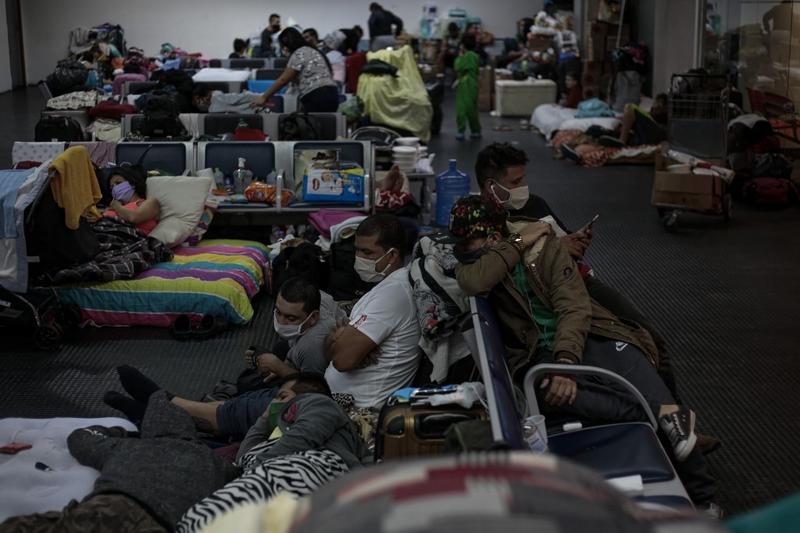China provides supplies, expertise to fight pandemic in Latin America
 (SONG CHEN / CHINA DAILY)
(SONG CHEN / CHINA DAILY)
Hu Feifei, from Chifeng in China’s Inner Mongolia autonomous region, lived happily in Brazil for over six years, starting a business and a family.
Life changed for the 34-year-old when COVID-19 struck.
“Before the outbreak, I operated a Chinese-language school in Rio de Janeiro, with more than 100 students attending each day for a course in the language and Chinese culture,” Hu said, citing warming Sino-Brazilian relations and job opportunities from Chinese enterprises investing in Brazil as cause for recent interest.
“Last month, Brazil saw a surge in the number of confirmed COVID-19 cases, and nearly all public schools have closed. I started to conduct my course through livestreaming on social media platforms. Surprisingly, this has attracted more students.”
Since the outbreak in Wuhan, Hubei province, Hu and her Brazilian husband Paulo had bought thousands of face masks, both for personal use and for family and friends in China.
“We also told our friends in Brazil to take the outbreak seriously and adopt measures to protect themselves,” Hu said. To safeguard her family, she stayed home for over a month, and her husband has only ventured out twice for groceries.
Li Di, from Beijing, who works for a Chinese infrastructure company in Rio de Janeiro, goes outdoors just once a week.
“I go out to shop for food or just for a walk. I wear an N95 face mask and disposable gloves every time. I think it’s OK to go outside and breathe fresh air if we have adequate protection,” said Li, who has been working from home for two months.
“The most important thing I have learned while working in Brazil is to be optimistic, which the locals are always telling me. They believe that humans will definitely defeat the virus.”
The pandemic is raging across Latin America, home to about 650 million people.
Brazil is the worst-hit nation in the region. By June 8, confirmed COVID-19 cases in the country numbered 691,962 — ranking second worldwide after the United States. A total of 36,499 Brazilians had died from the virus.
In Chile, home to 19 million people, new restrictions were imposed in Santiago, its capital, after cases doubled to more than 127,000.
Peru, which borders Brazil, has the eighth-highest number of confirmed COVID-19 cases in the world, with more than 196,000.
Many Latin American countries are introducing practical measures to mitigate the virus’ impact.
Rio de Janeiro saw traffic restrictions imposed in 10 districts and shops banned from reopening. In the northeastern state of Pernambuco, the local government declared a 15-day lockdown in state capital Recife and the metropolitan area.
The Brazilian government recently authorized testing of a COVID-19 vaccine developed by the University of Oxford. Brazil will be the second nation after the United Kingdom to test its efficacy, according to the country’s National Health Surveillance Agency.
In Santiago, subway usage fell by 67 percent after President Sebastian Pinera declared a 90-day state of catastrophe on March 18. Chile and other Latin American countries have closed their borders and banned incoming flights, especially from areas with severe COVID-19 outbreaks.
In Mexico, a network of Chinese-made thermographic cameras have been installed outside shopping malls and office buildings in the capital Mexico City and other areas including Monterrey and Guadalajara.
 Stranded Colombian citizens remain at Guarulhos International Airport, in Guarulhos, near Sao Paulo, Brazil, on May 26, 2020. (MIGUEL SCHINCARIOL / AFP)
Stranded Colombian citizens remain at Guarulhos International Airport, in Guarulhos, near Sao Paulo, Brazil, on May 26, 2020. (MIGUEL SCHINCARIOL / AFP)
The cameras, using infrared sensors to measure body temperatures from a distance, will screen for fever, one of the main symptoms of infection.
In Argentina, the government launched “We Continue to Educate”, a program to provide households with educational content online, on public television and on radio networks. Education Minister Nicolas Trotta said it would provide all the necessary educational tools for continual learning.
Luis Alfredo Tellez, head of the Department of Communications at the University of San Buenaventura in Bogota, capital of Colombia, said the health crisis is a good opportunity for the institution to upgrade its online courses.
Latin American nations are also struggling with insufficient medical supplies. Last month, over 90 percent of intensive care beds were occupied in Santiago.
In cities across the region, doctors reported ventilator shortages, and patients could not get to hospitals quickly. Officials plan to move patients from national capitals, including Lima (Peru) and Santiago, to hospitals in smaller cities. However, they risk further spreading the disease.
Overworked health workers have also complained of limited access to testing.
Infections from Latin America’s markets are another reason for the surge in COVID-19 cases.
At a major fruit market in Lima, four out of five merchants tested positive for the virus, prompting fears that traditional trading centers have helped spread the disease across the region.
Some 79 percent of stall holders at the wholesale market tested positive for COVID-19. Spot tests at five other large fresh food markets in the city showed at least 50 percent were infected.
The Guardian quoted a former deputy mayor of Lima as saying: “The contagion among merchants is terribly high and we don’t know how long they’ve had it or how many people they’ve passed it on to.”
The Corabastos wholesale market in Bogota — the largest in Colombia — is the country’s COVID-19 epicenter. The vast area was reportedly advised to operate at 35 percent capacity after dozens of cases were detected. Shoppers have reportedly failed to observe social distancing or wear face masks.
In Beijing, Pan Deng, executive director of the Latin America and Caribbean Region Law Center at China University of Political Science and Law, said the outbreak is a big challenge for Latin America’s public health systems.
“The region’s economy relies heavily on the international market and external funds, and the outbreak has disrupted normal operation of the world’s economic structure and supply chains. In the early stages of the outbreak, many countries in the region were faced with a shortage of materials and testing kits, which was not conducive to quickly controlling the pandemic,” Pan said.
Some Latin American cultural habits, including the preference for outdoor activities and social gatherings, have made it difficult for governments to enforce quarantine measures, Pan said.
Wang Huizhi, an assistant researcher in the Latin American and Caribbean Department at the China Institute of International Studies, said that Latin America is not fighting COVID-19 alone, with China and other countries providing assistance.
“Given the virulent nature of the virus and the fact that no country has dealt with it before and can beat it alone, China has shared its experience in fighting it with many Latin American countries and has quickly provided medical supplies to help our friends overcome their difficulties,” Wang said.
In March, a contingent of Chinese medical experts was dispatched to Latin American countries, beginning with Venezuela.
Venezuelan Foreign Affairs Minister Jorge Arreaza said: “With the experience that China has been able to gather in recent months, we know that many lives will be saved.”
The second Chinese medical team — selected by the Guangdong Provincial Health Commission — left for Peru on May 22 on a mission organized by the National Health Commission.
Foreign Ministry spokesman Zhao Lijian said China would continue to support Latin America through the pandemic by sharing prevention, diagnosis and treatment knowledge, providing materials and helping to obtain supplies.
In March, the Jack Ma Foundation and Alibaba Foundation donated medical supplies to 24 Latin American countries. Some 2 million face masks, 400,000 test kits and 104 ventilators were provided for Argentina, Brazil, Chile, Cuba, Ecuador, the Dominican Republic and Peru, among others.
Catalina Bedoya, an epidemiologist at Mederi University Hospital in Bogota, said Latin American governments can learn from China’s experience.
“Once the Chinese authorities realized that they were facing a novel coronavirus outbreak in the central city of Wuhan, they acted swiftly and decisively to contain it. China demonstrated its capacity to build hospitals in 10 days and its determination to save the lives of all COVID-19 patients,” Bedoya said.
Fernando Ferry, an infectious diseases expert in Brazil, said Latin America should adopt China’s strict quarantine and containment measures.
“COVID-19 is a disease with a high rate of transmission ... so we either follow the Chinese model of containment or see many more victims,” he said.
Wang, from the China Institute of International Studies, said Latin America faces the dual pressure of fighting COVID-19 and reviving economies.
“On the one hand, the region needs to strengthen its health systems to cope with the crisis. On the other, economic and social measures are needed to mitigate the enormous negative consequences of isolation,” Wang said.
“This is not just a test for governments in Latin America, but a test for the rest of the world. It will be a test of whether governments can continue to deal with other countries in a multilateral and humanitarian manner, maintain global economic stability and jointly combat the epidemic under the impact of the economic downturn.”
Xinhua and agencies contributed to this story.


